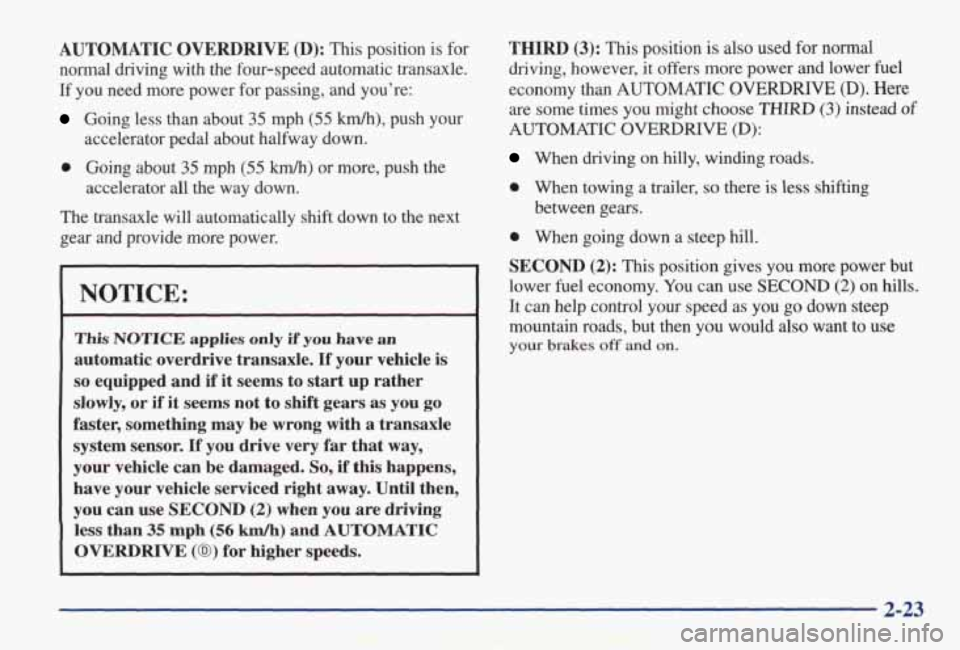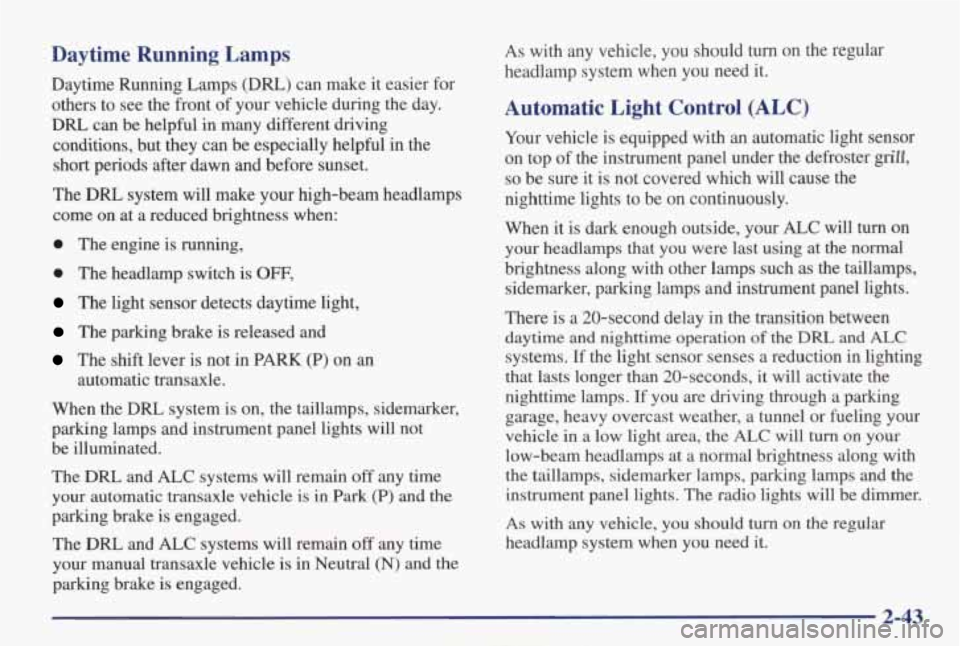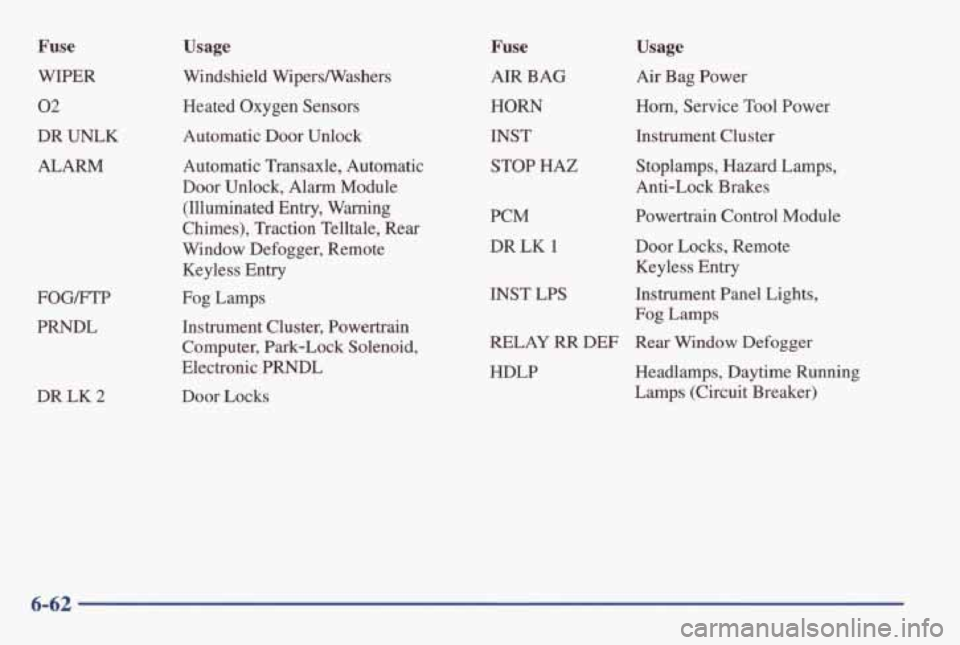brake sensor PONTIAC GRAND AM 1998 Owners Manual
[x] Cancel search | Manufacturer: PONTIAC, Model Year: 1998, Model line: GRAND AM, Model: PONTIAC GRAND AM 1998Pages: 370, PDF Size: 16.11 MB
Page 84 of 370

AUTOMATIC OVERDRIVE (D): This position is for
normal driving with the four-speed automatic transaxle.
If you need more power for passing,
and you’re:
Going less than about 35 mph (55 km/h), push your
0 Going about 35 mph (55 km/h) or more, push the
The transaxle will automatically shift down to the next
gear and provide more power. accelerator pedal about halfway down.
accelerator all the way down.
NOTICE:
This NOTICE applies only if you have an
automatic overdrive transaxle. If your vehicle is
so equipped and if it seems to start up rather
slowly,
or if it seems not to shift gears as you go
faster, something may be wrong with a transaxle
system sensor.
If you drive very far that way,
your vehicle can be damaged. So, if this happens,
have your vehicle serviced right away. Until then,
you can use SECOND
(2) when you are driving
less than
35 mph (56 km/h) and AUTOMATIC
OVERDRIVE (0) for higher speeds. THIRD
(3): This
position is also used for normal
driving, however, it offers more power and lower fuel
economy than AUTOMATIC
OVERDRIVE (D). Here
are some times you might choose THIRD (3) instead of
AUTOMATIC
OVERDRIVE (D):
When driving on hilly, winding roads.
0 When towing a trailer, so there is less shifting
between gears.
0 When going down a steep hill.
SECOND
(2): This position gives you more power but
lower fuel economy. You can use
SECOND (2) on hills.
It can help control your speed
as you go down steep
mountain roads, but then you would also want
to use
your brakes off and on.
2-23
Page 104 of 370

Daytime Running Lamps
Daytime Running Lamps (Dm) can make it easier for
others to see the front of your vehicle during the day.
DRL can be helpful in many different driving
conditions, but they can be especially helpful in the short periods after dawn and before sunset.
The
DRL system will make your high-beam headlamps
come on at a reduced brightness when:
0 The engine is running,
0 The headlamp switch is OFF,
The light sensor detects daytime light,
The parking brake is released and
The shift lever is not in PARK (P) on an
When the DRL system is on, the taillamps, sidemarker,
parking lamps and instrument panel lights will not
be illuminated. automatic transaxle.
The
DIU and ALC systems will remain off any time
your automatic transaxle vehicle is
in Park (P) and the
parking brake is engaged.
The
DFU and ALC systems will remain off any time
your manual transaxle vehicle is in Neutral
(N) and the
parking brake is engaged.
As with any vehicle, you should turn on the regular
headlamp system when you need it.
Automatic Light Control (ALC)
Your vehicle is equipped with an automatic light sensor
on top of the instrument panel under the defroster
grin,
so be sure it is not covered which will cause the
nighttime lights to be on continuously.
When it is dark enough outside,
your ALC will turn on
your headlamps that you were last using at the normal
brightness along with other lamps such as the taillamps,
sidemarker, parking lamps and instrument panel lights.
There is a 20-second delay in the transition between
daytime and nighttime operation
of the DRL and LC
systems. If the light sensor senses a reduction in lighting
that lasts longer than 20-seconds, it will activate the
nighttime lamps. If you are driving through a parking
garage, heavy overcast weather, a tunnel or fueling your
vehicle in a low light area, the
ALC will turn on your
low-beam headlamps at a normal brightness along with
the taillamps, sidemarker lamps, parking lamps and the
instrument panel lights. The radio lights will be dimmer.
As with any vehicle, you should turn on the regular
headlamp system when you need
it.
Page 295 of 370

Fuse
WIPER
02
DR UNLK
ALARM
FOG/FTP
PRNDL
DR LK
2
Usage
Windshield Wipersmashers
Heated Oxygen Sensors
Automatic Door Unlock
Automatic Transaxle, Automatic
Door Unlock, Alarm Module (Illuminated Entry, Warning
Chimes), Traction Telltale, Rear
Window Defogger, Remote
Keyless Entry
Fog Lamps
Instrument Cluster, Powertrain
Computer,
Park-Lock Solenoid,
Electronic PRNDL
Door Locks
Fuse
AIR BAG
HORN
INST
STOP HAZ
PCM
DR LK
1
Usage
Air Bag Power
Horn, Service Tool Power
Instrument Cluster
Stoplamps, Hazard Lamps,
Anti-Lock Brakes
Powertrain Control Module
Door Locks, Remote
Keyless Entry
Fog Lamps
INST LPS Instrument Panel Lights,
RELAY RR DEF Rear Window Defogger
HDLP Headlamps, Daytime Running Lamps (Circuit Breaker)
6-62